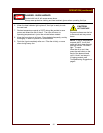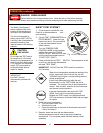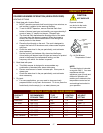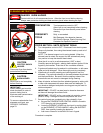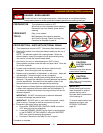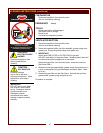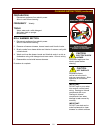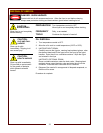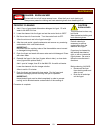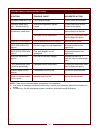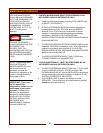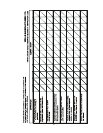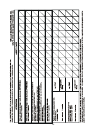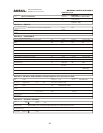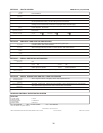
23
MAINTENANCE
CAUTION
BURN HAZARD
This procedure involves very
hot liquids.
Wear protective clothing and
heat-resistant gloves.
Periodic cleaning is
necessary to remove
carbonization from the
elements and frypot.
Frypot may be cleaned by
the method described at
right, or with a commercial
frypot cleaner. Be sure to
follow the manufacturer's
directions.
Before cleaning, ALWAYS:
• Disconnect the fryer
from electric power and
allow to cool.
• Drain the oil and wipe
out the frypot.
PERIODIC CLEANING
1. Add 1/2 cup of granulated dishwasher detergent to frypot. Fill with
water to the MAX OIL line.
2. Lower the element into the frypot and set the control knob to 225ºF
3. Boil the mixture for five minutes. Turn the control knob to OFF.
Allow the mixture to set in the frypot overnight.
4. After the soak period, raise the elements and remove any remaining
carbonization with a stiff bristle brush.
IMPORTANT:
Be careful that the capillary tubes of the thermobulbs are not moved
or damaged during cleaning.
5. Drain the frypot and wash with warm water and mild detergent. Rinse
with clean water.
6. Reinstall the frypot in the fryer (frypots without drain), or close drain
valve (frypots with optional drain).
Add 1 quart of vinegar, then fill to the MAX OIL line with cold water.
Lower the elements into the vinegar solution.
Allow to set for 15 minutes.
7. Drain the frypot and rinse with clean water. Dry the frypot and
elements thoroughly before returning the fryer to operation.
IMPORTANT:
Nickel plated frypot must be dried completely in order to prevent
rusting, and to eliminate water contamination of the cooking oil.
Procedure is complete.
DANGER: BURN HAZARD
Contact with hot oil will cause severe burns. Allow the fryer to cool draining oil.
Always wear protective clothing and heat resistant gloves when handling hot oil.



